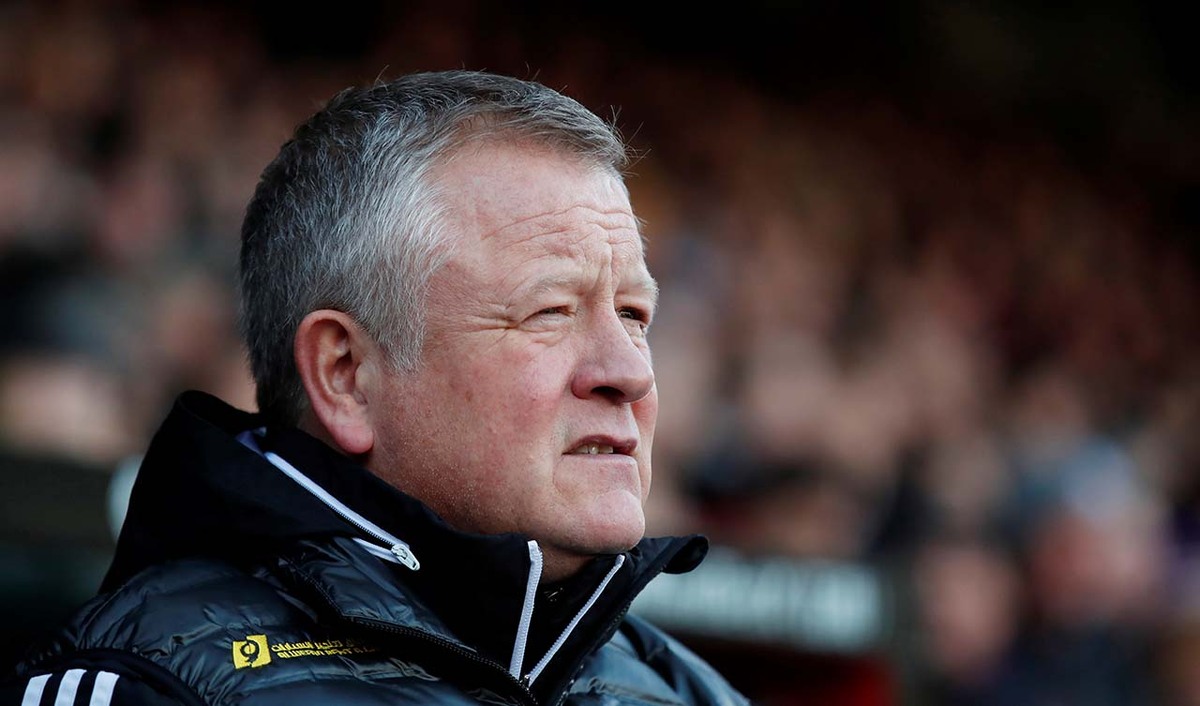You are viewing 1 of your 1 free articles
Pressing to win the ball
| Area | Up to full pitch |
| Equipment | Balls, bibs, cones, mannequin, 6 mini goals, 2 full size goals |
| No. of Players | Up to 20 players + 2 goalkeepers |
| Session Time |
2v2 practice: 15mins, 10v5 pressing: 20mins, 10v10 pressing: 20mins |
In a lot of the sessions we run at Sheffield United, we want the players to press and win the ball back as quickly as possible. It’s a big part of our game and something that we work on a lot. It comes into nearly every session that we do, but we will have some sessions, like this one, where the real focus is on pressing–and pressing to win the ball back as high up the pitch as possible.
It’s physically demanding to play this way, so it’s important the whole team is committed to the idea and that you don’t end up with just two or three players trying to press in isolation. It always shows the strength of a group if they enjoy the tough sessions and demand more from each other. For us, it is so important for the mentality of the group that they pull each other through these sessions and get used to working as hard as we want them to on a match day.
We focus on pressing in this session but it incorporates so much more. By getting players to press the ball quickly, it puts the possession player under pressure to make a quicker decision and helps him learn to deal with playing in tight spaces. We always look for players to make positive decisions, so training with this pressure helps us–both in and out of possession.
We would generally do a session like this on a Tuesday or Wednesday if we were playing on a Saturday. It’s important that we’re able to maximise what we get physically from the session, with enough space before the next game so that the players aren’t fatigued.
What do I get the players to do?
2v2 practice
After a warm-up, we set up a tight area of 24x22 yards, with a mannequin in the centre and a goal and a goalkeeper at each end. We are using four outfield players for this 2v2, as shown[1].
The practice begins with one of the goalkeepers playing a pass to the player on the mannequin, who passes back to the keeper. The other three players are doing SAQ work through some equipment outside the area; they are preparing to run onto the pitch as quickly as possible.
It should be timed so that when the keeper receives the return pass, all of the players are on the pitch ready for the 2v2 to commence with a second pass out from the keeper.
The team out of possession have to continually press the ball to stop the opposition from getting a shot on goal. The game is then played for 45-90 seconds, depending on how hard you want the players to work.
The size of the pitch is kept tight, so the intensity of the practice is extremely high. We try to ensure we do this type of work when the players are freshest, so that we get the maximum intensity from them.
10v5 pressing
Next we set up an area of 46x30 yards with three mini goals at each end.We are using 15 players, split into three teams of five. One team is designated to press and win the ball back, while the other two teams work together, linking up to keep possession, as shown[2]. If they string 10 passes together they score a point.
The pressing team should try to force play so they can cut off the possession players and take away the overload advantage. If the pressing team wins the ball, they must try to score in one of the mini goals, meaning that the team of 10 have to transition from keeping the ball to quickly trying to stop the team of five from scoring.
What are the key things to look out for?
In the 10v5 practice, we are looking for the team out of possession to try and press even though they are playing against an overload. As a result, we are looking for them to choose the right time to press and then, once the first player goes to make contact, his teammates must follow in to try to put as much pressure on the ball as possible. It’s about trying to go from being outnumbered as a defensive team to forcing the opposition into a smaller area where the numbers become more like 5v4 or 4v4.
What do I get the players to do next?
10v10 pressing We set up between the two penalty areas of a full pitch, with a goal and a goalkeeper at each end. We divide the playing area into four zones. We are using 20 outfield players, divided evenly into two teams of 10.
Play starts with a pass out from the goalkeeper to a player in the same zone, as shown[3]. At first the ball can only be can only be passed from one zone into the next – no cutting out zones. By playing out from the goalkeeper into the first zone, we would expect to see the opposition press high up the pitch. We would also look for the teams to squeeze up the pitch and ensure that they are occupying as few zones as possible as a team.
It’s a normal game, but at times we will limit the touches that players can have in certain zones, meaning the ball will move quicker and teams will have to adjust to be able to press and get pressure on the ball. Offside applies from the halfway line.
To finish the session we would then turn this into a full 11v11 game.
What are the key things to look out for?
The most important thing is that the players work hard and show the kind of application and honesty that we are after. Players should be willing to organise each other and pass on information. Pressing demands that players work together and so we are looking for that organisation from players when they go after the ball together.
Most importantly, we are asking the pressing players to get lots of bodies around the ball. If one or two players go to press the ball, then everybody else has to close the distances to each other in order to limit the time and space the opposition players have. It’s also about the intensity of these actions.
What are the typical mistakes players might make and how do I avoid them?
The biggest thing for us in this session is obviously the work rate. If a player isn’t pressing, then it will show and we would expect players to police that themselves in the first instance.
From a tactical perspective, we sometimes see players going to press as individuals, without the support of teammates.We would always encourage the first man to go and get the ball, and it’s then the responsibility of those behind or around him to follow, shutting off passing options and trying to win the ball.
There are times, of course, when you can’t press and it’s about the players recognising this and ensuring they don’t just get picked off.
Related Files
Editor's Picks
Deep runs in the final third
Using the goalkeeper in build-up play
Pressing principles
Intensive boxes drill with goals
Penetrating the final third
Creating and finishing
My philosophy
Pressing initiation
Compact team movement
Coaches' Testimonials

Alan Pardew

Arsène Wenger

Brendan Rodgers

Carlos Carvalhal

José Mourinho

Jürgen Klopp

Pep Guardiola

Roy Hodgson

Sir Alex Ferguson

Steven Gerrard
Coaches' Testimonials

Gerald Kearney, Downtown Las Vegas Soccer Club

Paul Butler, Florida, USA

Rick Shields, Springboro, USA

Tony Green, Pierrefonds Titans, Quebec, Canada
Join the world's leading coaches and managers and discover for yourself one of the best kept secrets in coaching. No other training tool on the planet is written or read by the calibre of names you’ll find in Elite Soccer.
In a recent survey 92% of subscribers said Elite Soccer makes them more confident, 89% said it makes them a more effective coach and 91% said it makes them more inspired.
Get Monthly Inspiration
All the latest techniques and approaches
Since 2010 Elite Soccer has given subscribers exclusive insight into the training ground practices of the world’s best coaches. Published in partnership with the League Managers Association we have unparalleled access to the leading lights in the English leagues, as well as a host of international managers.
Elite Soccer exclusively features sessions written by the coaches themselves. There are no observed sessions and no sessions “in the style of”, just first-hand advice delivered direct to you from the coach.









